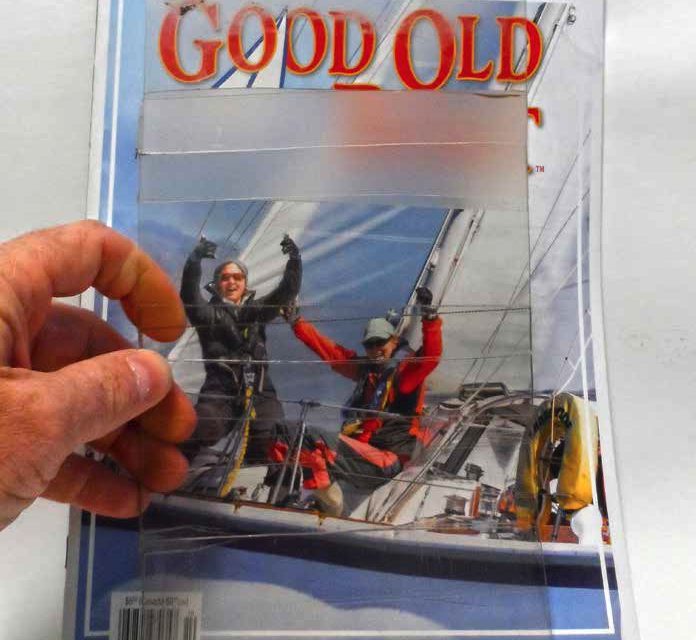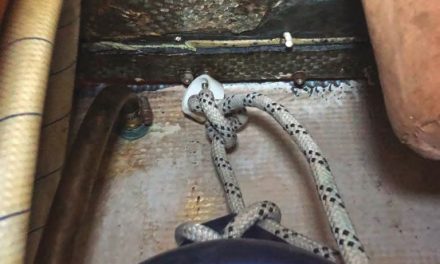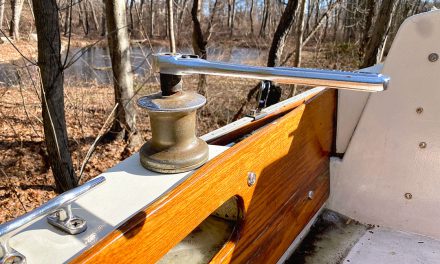Tape can provide a quick fix for torn or cracked vinyl windows
Issue 152: Sept/Oct 2023
Eventually a vinyl window will crack, either because of extreme age or extreme cold. The right fix is new vinyl, but in the meantime, we need a quick fix — something fast, easy, and good enough to get us to the end of the cruise or season. If the repair could last a few seasons, that would be grand. Canvas work is expensive and sewing machines hate me. Semiflexible solar panels get scratched. The damage is usually very localized, but unless you seal any cracks, and quick, moisture will enter, ruining the whole panel.
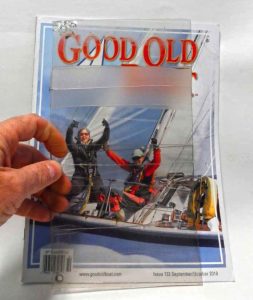
The author holds a section of repaired
vinyl that has spent a year in the sun. The Tear-Aid tape (top), is nearly opaque and not very strong. The Gorilla tape (middle) is clear and a little stronger, but is still weak and has a visible pinked edge, while the Scotch Book Tape (bottom) became stronger over time, did not yellow, and is nearly invisible.
I got my first vinyl window crack about nine years ago. As I rolled down a yellowed window on my boat’s cockpit dodger, it snapped halfway across. Packing tape, carefully applied to both sides, lasted through the cruise and the following winter. At considerable expense ($1,500), I had new windows made in the spring, just as the tape began to fail. The tape was some cheap off-brand stuff we had on the boat, and I wondered if the right tape might last years.
I set about testing a variety of methods, including Scotch Heavy Duty Packaging Tape, Scotch Book Tape, and Crystal Clear Gorilla Tape, as well as some specialty repair products. Those included Tear-Aid Type B, a specialized repair tape for soft vinyl, and ISC Racers Tape, a tough polyurethane tape used to protect automotive paint and aircraft edges from dings. Finally, I tried gluing on patches with West System G/ flex Epoxy and Loctite vinyl repair glue. I tested these using aged vinyl sections from the local canvas shop.
I tested each repair three ways. First, I made up long 2-inch-wide strips of vinyl so that I could compare visibility and flexibility. Then I made a series of test coupons with the various materials, which were slowly pulled in a test rig to determine creep resistance at several temperatures and ultimate strength. Finally, I made 8 x 10 panels with each material for our aging rig and left them in the sun for a year, after which they were observed and retested.
At first, I assumed clarity would be a major factor, but most window cracks happen down low, near the deck and below the view line. Reflection off the deck doubles UV exposure, and there is often additional stress from rolling down the window, the wind, and dodger fit/shrinkage issues. Patches in the bottom few inches or corners are not very noticeable in most cases, so I gave clarity less weight than durability.
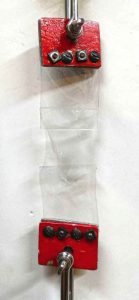
The author puts Gorilla tape through a stretch test.
Glued patches held the promise of durability, but ease of use and results were disappointing. Epoxies simply would not bond, peeling with the slightest flexing. Vinyl glues were better, but there was still the problem of applying the patch. Even if clamping is not required, the patch must lie flat, and if the window is already cracking, taking it off may ruin it. On the boat, the best I could do was mask all around the test area, attach the patch with masking tape, and hold it with my fingers or tape until the glue grabbed. Glued patches always contained bubbles, resulted in poor visibility, and created a hard spot, encouraging new cracks. The glued patches also fared poorly in the sun, yellowing and cracking after a year. Since most cracks are the result of age-induced brittleness, this seemed bad. Glue was out.
Tapes, on the other hand, were easy to apply, relatively inconspicuous (Tear-Aid Type B is translucent; others are clear), and nearly as strong as the vinyl if carefully applied from both sides. If the result is not perfect or does not last long enough, it’s easy to do it over — just peel off the tape, clean the surface with mineral spirits, follow with a soap and water rinse, and try again.
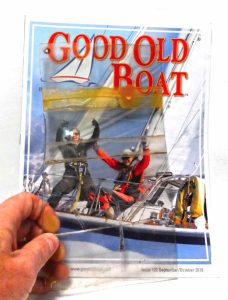
The author holds another section of repaired vinyl that has spent a year in the sun. The G/flex tape (top) is yellowed and peels easily if flexed. The Loctite tape (middle) is stronger, but difficult to apply and quite visible. The Scotch Heavy Duty
Packaging Tape (bottom) became more visible with time and is not as strong as Scotch Book Tape.
Heat can reveal weakness. Gorilla tape, Tear-Aid Type B, and ISC Racers Tape all stretched out of shape when constant stress was applied in warm weather. Scotch Heavy Duty Packaging Tape was better, but the real winner for vinyl windows was Scotch Book Tape. Designed for long-term restoration of damaged books, it did not creep in the heat, handled UV for years, and was nearly as strong as the vinyl (38 pounds/inch). Its appearance depends on controlled bubble- and wrinkle-free installation, but that is a matter of patience.
The semiflexible solar panel on my Corsair F-24 trimaran has taken some licks. Over 10 years it has been nicked by winch handles, scratched by the gooseneck while lowering the mast, and received a few more insults I can’t remember. A neat Scotch Book Tape repair patch is nearly invisible and lasts about two years, after which you can peel it off (light application of heat and a dull drywall knife help) or just apply another layer. Even better, ISC Racers Tape holds up for more than three years while staying clear and resisting impact, but it is harder to remove and replace. It’s a toss-up, and ISC Racers Tape is considerably more expensive. But the patches are working, and my 10-year-old, 50-watt, $100 semiflexible solar panel is still putting out respectable amps with no visible bad areas six years after the first serious damage occurred.
Scotch Book Tape is the big winner. It’s easy to find on Amazon, simple to apply, strong, and most importantly, durable. If it’s carefully applied on both sides of a vinyl dodger window, you should get two or three years from a repair that will take only minutes. For solar panels, ISC Racers Tape is the more durable option, but I’ve also been happy with the book tape.
Good Old Boat Technical Editor Drew Frye draws on his training as a chemical engineer and pastimes of climbing and sailing to solve boat problems. He cruises Chesapeake Bay and the mid-Atlantic coast in his Corsair F-24 trimaran, Fast and Furry-ous, using its shoal draft to venture into less-explored waters. He is most recently author of Rigging Modern Anchors (2018, Seaworthy Publications).
Thank you to Sailrite Enterprises, Inc., for providing free access to back issues of Good Old Boat through intellectual property rights. Sailrite.com

